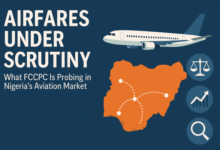NPA Sets Ambitious N1.28 Trillion Revenue Target for 2025, Anchors Growth on Port Modernisation and Blue Economy Expansion

In a bold fiscal move that signals growing optimism in Nigeria’s maritime sector, the Nigerian Ports Authority (NPA) has unveiled a revenue target of ₦1.279 trillion for the 2025 fiscal year—a significant 40% leap from the ₦865 billion originally projected for 2024, and one that underscores the agency’s renewed strategic drive to reposition Nigeria’s ports as the gateway of West Africa’s Blue Economy.
Speaking during the 2025 budget defence session before the Senate Committee on Marine Transport, NPA’s Managing Director, Dr. Abubakar Dantsoho, highlighted that the agency had already surpassed its 2024 revenue forecast, generating ₦894.86 billion, and remitted ₦400 billion into the Consolidated Revenue Fund (CRF)—nearly double its 2023 contribution.
“Our 2025 budget proposal is more than just figures—it reflects our aspirations for a globally competitive, tech-driven, and investment-friendly port ecosystem,” Dantsoho asserted.
Breaking Down the ₦1.279 Trillion Projection
- Cargo Dues – ₦430 billion
- Ship Dues – ₦544 billion
- Concession Fees – ₦240 billion
- Administrative Charges – ₦73 billion
This revenue blueprint is underpinned by an ambitious capital investment framework, with over 70% of projected expenditure earmarked for infrastructure and technological upgrades across Nigeria’s seaports. The plan includes:
- Full marine activation of the Dangote Refinery, expected to catalyse throughput volumes and related port revenue
- Deployment of next-generation port technology, including automation, digital customs integration, and vessel traffic systems
- Expansion and modernisation of port access roads and inland waterways to decongest Apapa and Tin Can Island corridors
- Enhanced Public-Private Partnerships (PPPs) to drive innovation in terminal operations, ship handling, and port security
Strategic Maritime Vision Amid Blue Economy Push
The NPA’s 2025 outlook is deeply aligned with Nigeria’s broader Blue Economy Agenda, which aims to harness the potential of the country’s 853km coastline, deep-sea assets, and inland water transport to diversify national income and create employment. By ramping up port efficiency, modernising critical infrastructure, and deepening concessionaire collaborations, the NPA is positioning itself as a cornerstone of this emerging maritime strategy.
The Authority’s plan comes at a time when competition from neighbouring ports—particularly Lomé, Cotonou, and Tema—is heating up, and Nigeria must address persistent challenges around cargo dwell time, port congestion, and bureaucratic bottlenecks.
Senate’s Call to Action
Chairman of the Senate Committee on Marine Transport, Senator Wasiu Eshinlokun (APC-Lagos), commended the NPA’s forward-looking revenue stance but urged faster reforms.
“Our ports are a vital pillar of economic revival. The NPA must scale up performance, improve infrastructure, and become a catalyst for tackling Nigeria’s twin challenges of revenue shortfall and youth unemployment,” he charged.
Senator Eshinlokun also stressed the need for the NPA to build resilience against global supply chain disruptions and domestic logistics constraints, calling for greater alignment with the federal government’s Renewed Hope economic blueprint.
Looking Ahead
If executed as planned, the NPA’s ₦1.279 trillion revenue ambition will not only mark a historic high for the Authority but could also unlock billions in private investment, enhance Nigeria’s maritime competitiveness, and deepen the integration of port services into the broader non-oil economy.
The stakes are high, but so are the expectations.
BRANDECONOMY INSIGHT:
With global maritime trade evolving rapidly—driven by digitisation, decarbonisation, and security concerns—Nigeria’s port system must accelerate reforms or risk being outpaced by regional peers. The NPA’s 2025 blueprint is a step in the right direction, but execution, political will, and private sector collaboration will determine whether this vision turns into verifiable impact.
Tools










